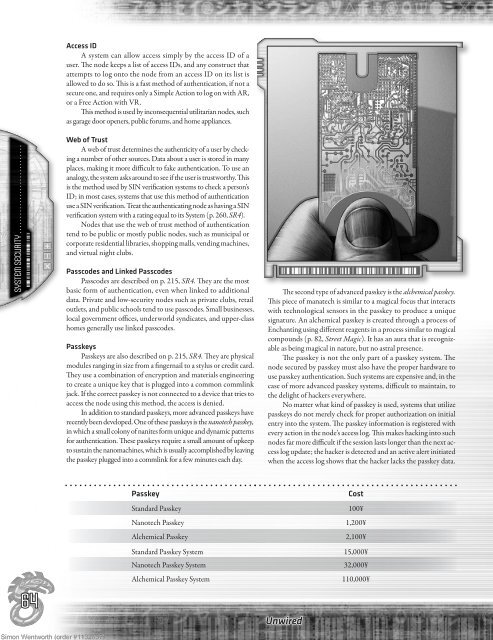comStar Firewall alert - PhaseThrough
comStar Firewall alert - PhaseThrough
comStar Firewall alert - PhaseThrough
You also want an ePaper? Increase the reach of your titles
YUMPU automatically turns print PDFs into web optimized ePapers that Google loves.
systeM security . . . . . . . . . . . . . . . . . . . . . . . . . . . . .<br />
64<br />
access id<br />
A system can allow access simply by the access ID of a<br />
user. The node keeps a list of access IDs, and any construct that<br />
attempts to log onto the node from an access ID on its list is<br />
allowed to do so. This is a fast method of authentication, if not a<br />
secure one, and requires only a Simple Action to log on with AR,<br />
or a Free Action with VR.<br />
This method is used by inconsequential utilitarian nodes, such<br />
as garage door openers, public forums, and home appliances.<br />
web of trust<br />
A web of trust determines the authenticity of a user by checking<br />
a number of other sources. Data about a user is stored in many<br />
places, making it more difficult to fake authentication. To use an<br />
analogy, the system asks around to see if the user is trustworthy. This<br />
is the method used by SIN verification systems to check a person’s<br />
ID; in most cases, systems that use this method of authentication<br />
use a SIN verification. Treat the authenticating node as having a SIN<br />
verification system with a rating equal to its System (p. 260, SR4).<br />
Nodes that use the web of trust method of authentication<br />
tend to be public or mostly public nodes, such as municipal or<br />
corporate residential libraries, shopping malls, vending machines,<br />
and virtual night clubs.<br />
passcodes and Linked passcodes<br />
Passcodes are described on p. 215, SR4. They are the most<br />
basic form of authentication, even when linked to additional<br />
data. Private and low-security nodes such as private clubs, retail<br />
outlets, and public schools tend to use passcodes. Small businesses,<br />
local government offices, underworld syndicates, and upper-class<br />
homes generally use linked passcodes.<br />
passkeys<br />
Passkeys are also described on p. 215, SR4. They are physical<br />
modules ranging in size from a fingernail to a stylus or credit card.<br />
They use a combination of encryption and materials engineering<br />
to create a unique key that is plugged into a common commlink<br />
jack. If the correct passkey is not connected to a device that tries to<br />
access the node using this method, the access is denied.<br />
In addition to standard passkeys, more advanced passkeys have<br />
recently been developed. One of these passkeys is the nanotech passkey,<br />
in which a small colony of nanites form unique and dynamic patterns<br />
for authentication. These passkeys require a small amount of upkeep<br />
to sustain the nanomachines, which is usually accomplished by leaving<br />
the passkey plugged into a commlink for a few minutes each day.<br />
The second type of advanced passkey is the alchemical passkey.<br />
This piece of manatech is similar to a magical focus that interacts<br />
with technological sensors in the passkey to produce a unique<br />
signature. An alchemical passkey is created through a process of<br />
Enchanting using different reagents in a process similar to magical<br />
compounds (p. 82, Street Magic). It has an aura that is recognizable<br />
as being magical in nature, but no astral presence.<br />
The passkey is not the only part of a passkey system. The<br />
node secured by passkey must also have the proper hardware to<br />
use passkey authentication. Such systems are expensive and, in the<br />
case of more advanced passkey systems, difficult to maintain, to<br />
the delight of hackers everywhere.<br />
No matter what kind of passkey is used, systems that utilize<br />
passkeys do not merely check for proper authorization on initial<br />
entry into the system. The passkey information is registered with<br />
every action in the node’s access log. This makes hacking into such<br />
nodes far more difficult if the session lasts longer than the next access<br />
log update; the hacker is detected and an active <strong>alert</strong> initiated<br />
when the access log shows that the hacker lacks the passkey data.<br />
Passkey Cost<br />
Standard Passkey 100¥<br />
Nanotech Passkey 1,200¥<br />
Alchemical Passkey 2,100¥<br />
Standard Passkey System 15,000¥<br />
Nanotech Passkey System 32,000¥<br />
Alchemical Passkey System 110,000¥<br />
Unwired<br />
Simon Wentworth (order #1132857) 9


